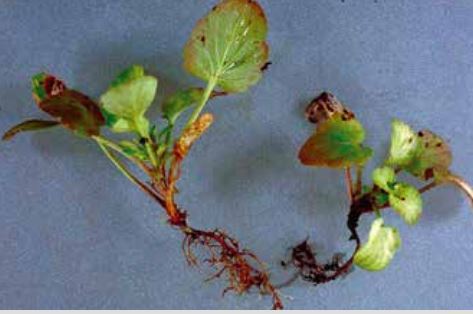Please click here to access the main AHDB website and other sectors.
- Home
- Knowledge library
- Black root rot in pansy and viola
Black root rot in pansy and viola
Common on nurseries, black root rot can be hard to diagnose but will have an impact on the performance of your crop. Learn how to recognise this disease and what you can do to control and correctly treat this important pathogen.
This information was last updated in 2014.
Go back to the main page: Controlling leaf and root diseases of pansy and viola
Spotting the symptoms
Black root rot is commonly found on nurseries during the summer, often at moderate to severe levels.
However, it is often misdiagnosed and incorrectly treated as a result, thus compounding the problem.
The disease is caused by the soil-borne fungus Thielaviopsis basicola. Unlike the mildews, this fungus is not host-specific and occurs commonly on many plant genera.
Attacking the roots
The fungus attacks the roots of the plant so its effects are not initially obvious.
Infected plants grow poorly and often develop a purpling of the older leaves, which may be mistaken for those of a nutrient deficiency, especially during the early stages of disease development (see Figure 1).
As the disease progresses, the roots become heavily colonised by the fungus and eventually decay.
 showing 'nutrient-like' deficiency symptoms. Dr G M McPherson..JPG) Dr G M McPherson
Dr G M McPherson
Figure 1. Early symptoms of black rot (Thielaviopsis basicola) showing 'nutrient-like' deficiency symptoms.
 RSK ADAS
RSK ADAS
Figure 2. Root symptoms in plants affected by Thielaviopsis basicola.
Severe infection
When infection is severe, plants become severely stunted and may rot off at the substrate surface.
Where black root rot is suspected, it is essential that the roots are examined closely for root discoloration and to do this effectively the substrate has to be thoroughly washed from the roots prior to inspection using a hand lens or similar.
If any roots are found to be black in colour this is indicative of infection by Thielaviopsis but a confirmatory diagnosis in a plant clinic facility may still be advisable.
If instead the roots, whilst still decayed, are a pale-brown colour this is more indicative of infection by Pythium .
Again, laboratory diagnosis is recommended to ensure appropriate control measures are used.
Disease development, spread and survival
The fungus produces two spore types on infected plants. One type is relatively short-lived but can aid in the rapid local spread of the pathogen whilst the other is black and thick- walled and found in infected roots and is capable of long-term survival and re-infection.
The disease develops under a wide range of conditions though it tends to be more severe where there is a high substrate moisture level coupled with poor aeration.
The pathogen grows best at around 17 to 23°C and at a pH of 5.7 to 5.9.
Contamination
The thick-walled spores of the fungus can survive in contaminated substrate, in dried roots on trays, pots and matting and on previously used non-disinfected trays and pots.
The fungus can be spread locally during irrigation via water- splash, on fragments of old infected plant debris and on infected plants themselves due to the persistence of the thick-walled spores, and over longer distances via wind-blown contaminated substrate dust.
Spore dissemination by sciarid flies has also been demonstrated.
Controlling black root rot
Effective hygiene measures are extremely important in terms of preventing root infection by Thielaviopsis .
Overwatering should also be avoided as the disease is favoured by waterlogging or overly wet growing media.
Where the pathogen is known to occur on a nursery, a routine protectant fungicide programme is advisable.
Unfortunately, fungicides previously known to have activity against this pathogen have recently been withdrawn from use and few alternatives are currently available with known activity.
Useful links
Download the original PDF version of this information from 2014
Read about bacterial diseases of protected ornamentals and possible control measures
Authors
Original authored by Andrew Jackson, Martin McPherson, and Wayne Brough.

